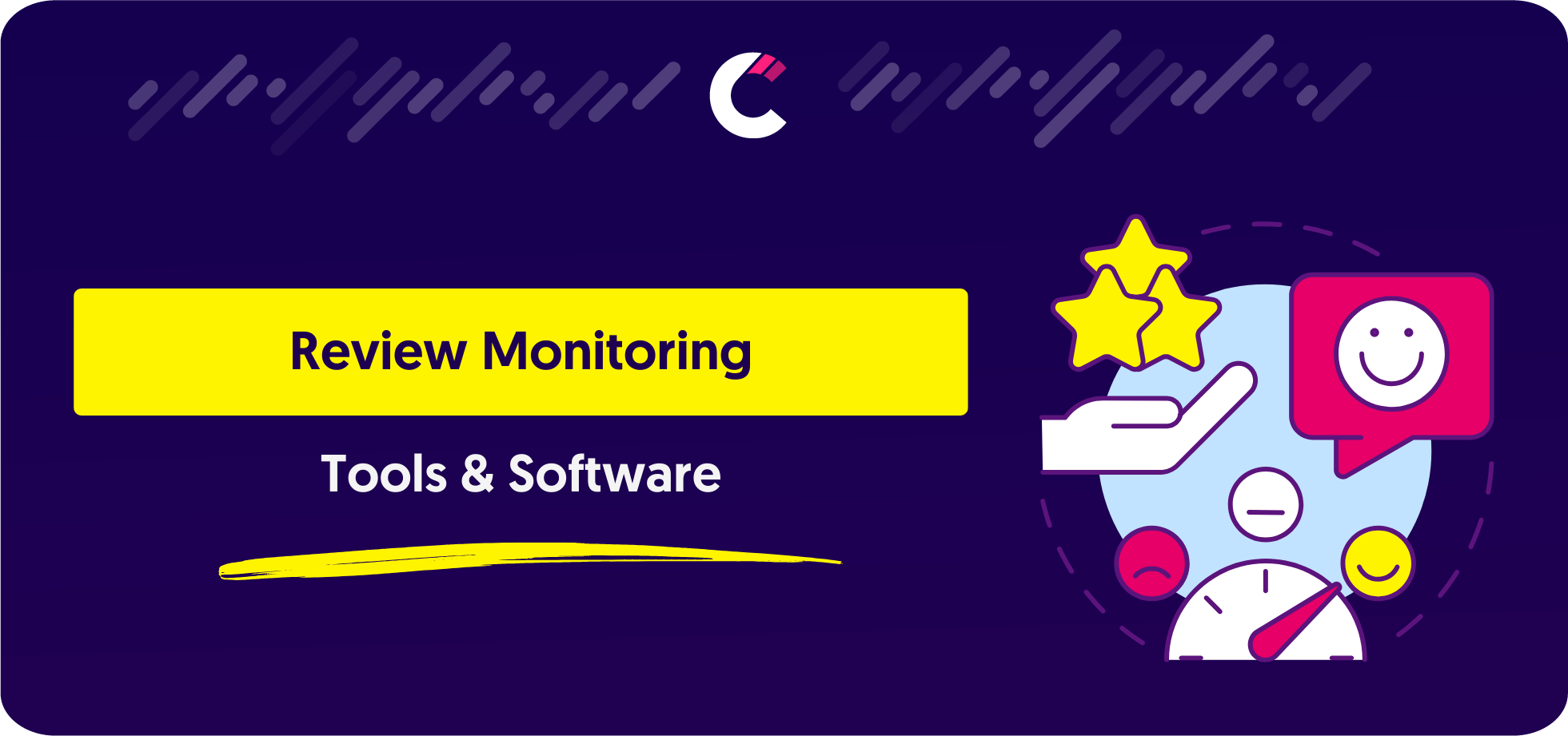
Have you ever wondered how successful businesses stay on top of their online reputation? In a world where a single review can shape a customer’s decision, managing these digital opinions is crucial. This is where review monitoring comes into play. It’s more than just keeping an eye on what people say; it’s about understanding the heartbeat of your customer base. Whether you’re a small business owner, a marketer, or just curious about the digital landscape, this article will explore the ins and outs of review monitoring, why it’s essential, and how to do it effectively. We’ll dive into the benefits, strategies, and even look at some tools and software that can make the process smoother. So, buckle up and get ready to explore the world of review monitoring—a key to unlocking customer insights and steering your business toward success.
Review monitoring is essentially the process of tracking and managing customer feedback on various online platforms. This includes keeping tabs on what customers are saying about your business on review sites, social media, and other digital channels. The goal is to get a clear picture of public perception about your products or services. It’s not just about spotting positive or negative reviews; it’s a comprehensive approach to understand customer experiences, expectations, and areas for improvement. Effective review monitoring helps businesses to promptly address customer concerns, improve their offerings, and build a strong online reputation, which is crucial in a digital-driven market.
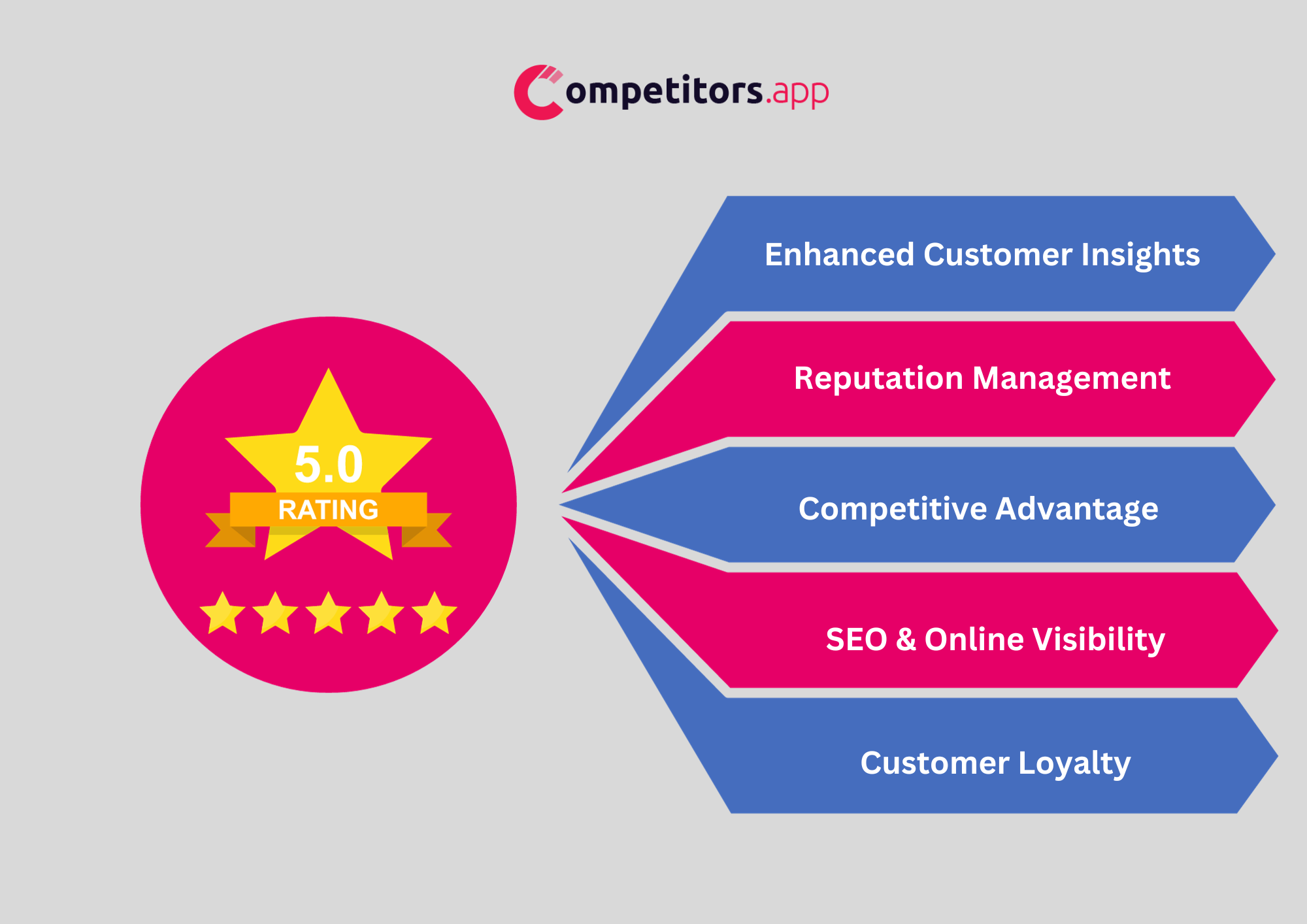
Understanding the benefits of online review monitoring is key to recognizing its value for any business. Some of the benefits can be summarized to the following:
Enhanced Customer Insights: Review monitoring provides a direct line to customer feedback, allowing you to understand their needs and preferences. This insight is crucial for tailoring your products or services to better meet customer expectations.
Reputation Management: Actively monitoring and responding to reviews helps in managing your online reputation. Addressing negative feedback quickly and constructively shows customers that you value their input and are committed to improving their experience.
Competitive Advantage: Keeping an eye on both your and your competitors’ reviews can offer valuable insights into market trends and customer pain points. This knowledge enables you to adapt and stay ahead in your industry.
Improved SEO and Online Visibility: Search engines favor websites with positive reviews, as they indicate trustworthiness and credibility. Regularly monitoring and encouraging customer reviews can boost your search engine rankings, leading to increased online visibility and potentially more business.
Customer Engagement and Loyalty: By responding to reviews, you engage with your customers directly, which can foster a sense of community and loyalty. This engagement is key to building lasting customer relationships and a strong brand image.
Incorporating review monitoring into your business strategy can lead to significant improvements in customer satisfaction, market positioning, and online presence.

A company’s reputation can be made or broken by online reviews. That’s where the pivotal role of review monitoring in reputation management comes into play. This process isn’t just about keeping tabs on what’s being said about your business; it’s about actively managing your brand’s image and customer perceptions. Here’s how review monitoring can be a game-changer in shaping your business reputation:
Early Detection of Issues: Review monitoring helps in early detection of potential problems. By keeping an eye on what customers are saying, you can identify and address issues before they escalate.
Building Trust and Credibility: Responding to reviews, especially negative ones, in a constructive and empathetic manner can significantly enhance your brand’s trust and credibility. It shows that you value customer feedback and are committed to resolving any concerns.
Shaping Public Perception: The way you handle reviews can shape public perception of your brand. Consistently positive interactions with customers can reinforce a positive image, while effectively addressing negative reviews can mitigate potential damage to your reputation.
Gathering Customer Insights for Improvement: Customer reviews are a goldmine of insights. They can highlight areas where your business excels and areas that need improvement. Acting on this feedback can lead to better business practices and increased customer satisfaction.
Enhancing Customer Experience: By monitoring and responding to reviews, you demonstrate that you value customer experience. This can lead to improved customer service, product enhancements, and a better overall experience for your customers.
By leveraging the power of review monitoring, businesses can not only protect but also enhance their reputation, ensuring a positive standing in the eyes of both current and potential customers.

Navigating the world of online reviews might seem daunting, but with the right approach, it can be straightforward and highly rewarding. Here’s a step-by-step guide to effectively track and monitor your online reviews:
Identify Relevant Platforms: Start by identifying where your customers are most likely to leave reviews. This could be on social media, industry-specific review sites, or general review platforms like Google or Yelp.
Set Up Alerts and Notifications: Many platforms offer alert systems to notify you when new reviews are posted. Utilizing these tools ensures you’re always in the know and can respond in a timely manner.
Regularly Check Review Sites: Even with alerts, it’s good practice to regularly visit review sites. Some reviews may slip through the cracks, so manual checks can be a helpful backup.
Use Review Monitoring Tools: There are various tools and software available that can streamline the review monitoring process. These tools can aggregate reviews from multiple sources, making it easier to track and manage reviews for your brand and your competitors. Our tool also helps in this field, you can try Competitors App for free to get started.
Analyze and Report: Don’t just read the reviews; analyze them for patterns and insights. Reporting these findings can help inform business strategies and improve customer experiences.
Respond to Reviews: Make it a point to respond to both positive and negative reviews. This engagement shows customers that you value their feedback and are committed to improving their experience.
Encourage Customer Feedback: Actively encourage your customers to leave reviews. The more feedback you receive, the better you can understand and serve your customer base.
By following these steps, businesses can effectively monitor online reviews, gain valuable insights, and use this information to improve their products, services, and overall customer experience.
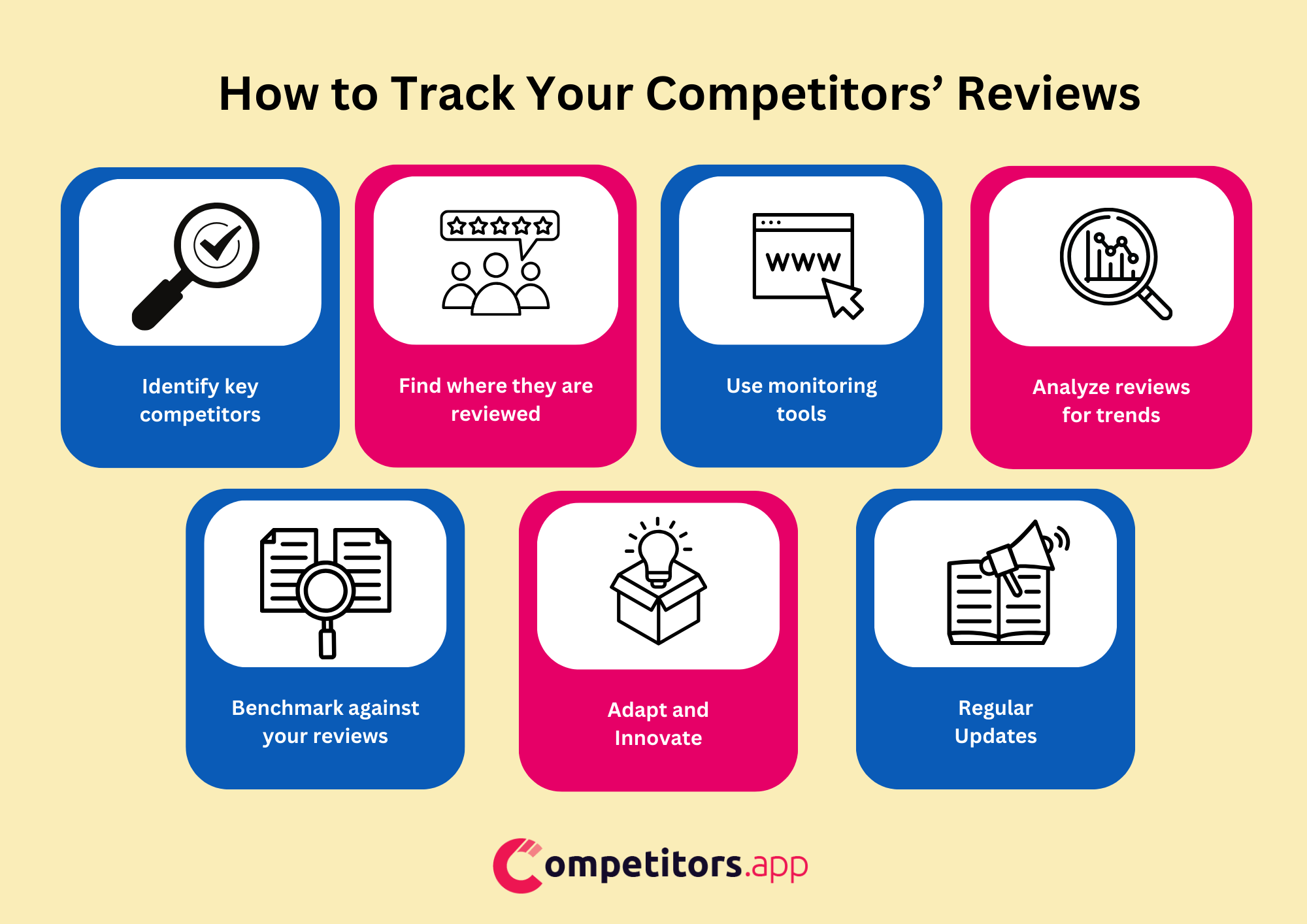
Keeping an eye on your competitors’ online reviews is just as important as monitoring your own. It’s a strategy that can provide valuable insights into market trends, customer expectations, and areas where you can differentiate your business. Here’s how you can effectively track and monitor your competitors’ reviews:
Identify Key Competitors: Start by identifying your main competitors. These could be businesses offering similar products or services in your industry.
Find Where They Are Reviewed: Research where these competitors are getting reviewed. This might include industry-specific platforms, general review sites, or social media channels.
Use Monitoring Tools: Leverage review monitoring tools that allow you to track multiple businesses. These tools can save time by aggregating reviews from various sources in one place.
Analyze Their Reviews for Trends: Look for patterns in your competitors’ reviews. Are there recurring complaints or praises? Understanding these can provide insights into what customers value or dislike in your industry.
Benchmark Against Your Reviews: Compare these findings with your own reviews. This comparison can highlight your strengths and areas for improvement relative to your competition.
Adapt and Innovate: Use the insights gained to adapt your strategies, services, or products. This can help you to offer something better or different than your competitors.
Regular Updates: Keep this process ongoing. Markets and customer preferences change, so staying updated with the latest reviews is crucial.
By systematically tracking and analyzing your competitors’ reviews, you can stay ahead of the curve, meet customer expectations more effectively, and carve out a unique position for your business in the marketplace.
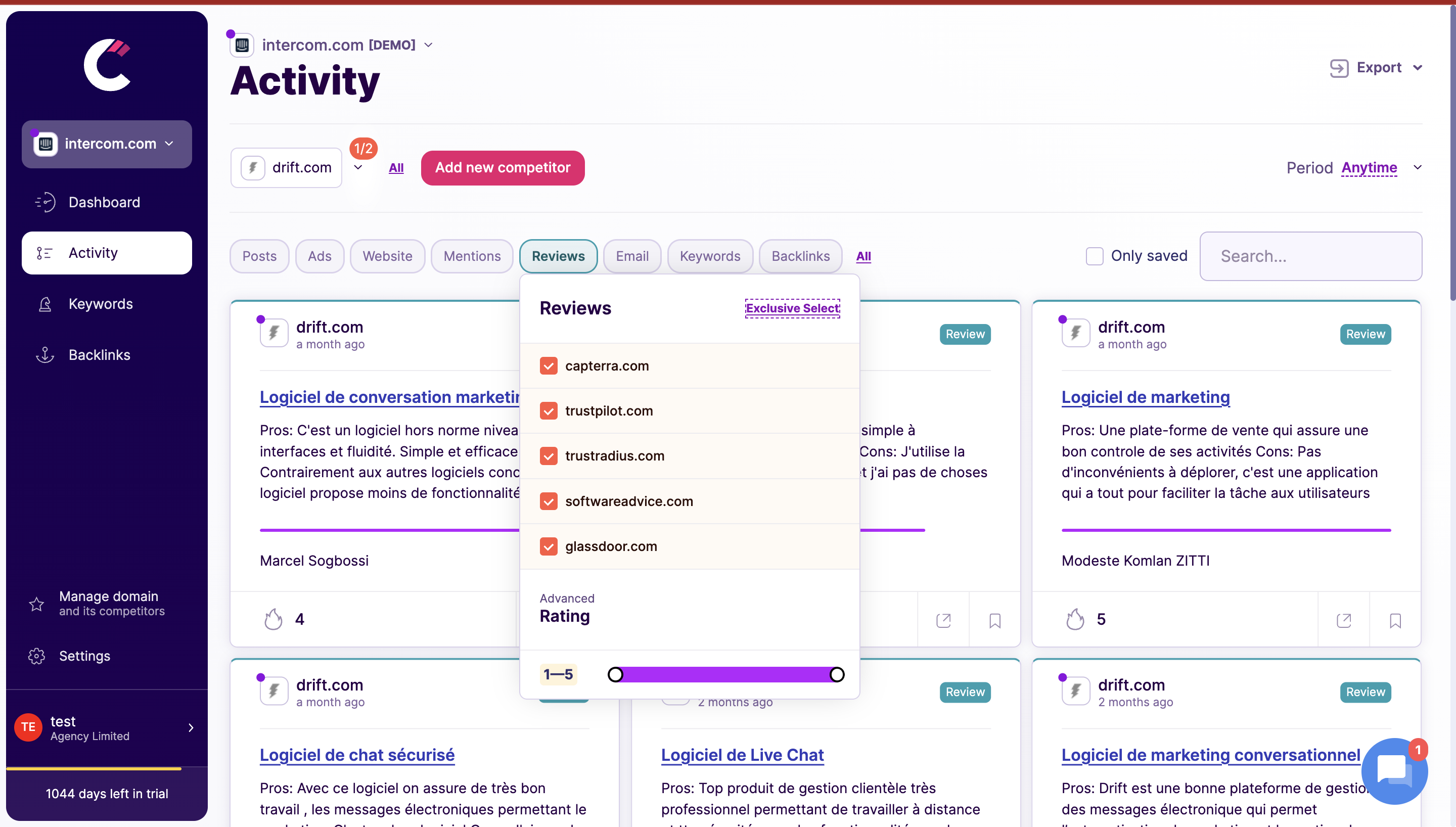
For businesses looking to gain an edge in review monitoring, especially concerning their competitors, the Competitors App can be a valuable tool. This application is designed to streamline the process of tracking and analyzing competitors’ reviews. Here’s how you can use the Competitors App to your advantage:
Set Up and Customize Your Account: Begin by setting up an account on the Competitors App. Customize your settings to focus on specific competitors and the review platforms that are most relevant to your industry.
Automated Tracking: The app automates the tracking process, gathering reviews from various platforms. This saves time and ensures you don’t miss any critical feedback.
Real-Time Alerts: Enable real-time alerts to be notified when new reviews are posted about your competitors. This feature helps you stay up-to-date with the latest customer sentiments.
Analyze Trends and Sentiments: The app provides tools for analyzing trends and sentiments in your competitors’ reviews. This can help identify what customers like or dislike about their products or services.
Benchmarking Features: Use the app’s benchmarking features to compare these reviews against your own. This comparison can reveal areas where you are outperforming your competitors or where there is room for improvement.
Reporting and Insights: Regular reports and insights provided by the app can inform your strategic decisions, helping you to refine your offerings and marketing strategies.
Adapt Based on Insights: Finally, use the insights gathered to adapt your business strategies. Whether it’s improving customer service, tweaking products, or altering marketing tactics, the information from the Competitors App can guide effective changes.
By utilizing the Competitors App, businesses can gain a comprehensive view of how they stack up against their competitors from a customer perspective, offering a strategic advantage in market positioning and business development.
Selecting the right tools for online review monitoring is crucial for effective reputation management. Here are some of the top software options designed specifically for monitoring and managing online reviews:

This tool goes beyond basic review monitoring by providing a wide array of competitive intelligence features. It tracks competitors' online activity, including social media presence, website changes, and email campaigns, in addition to monitoring reviews. This holistic approach gives businesses a fuller picture of their competitive landscape.

Offering a comprehensive suite of services including review monitoring, customer surveys, listing management, and a holistic customer experience platform, Birdeye is ideal for businesses seeking an all-encompassing reputation management solution.
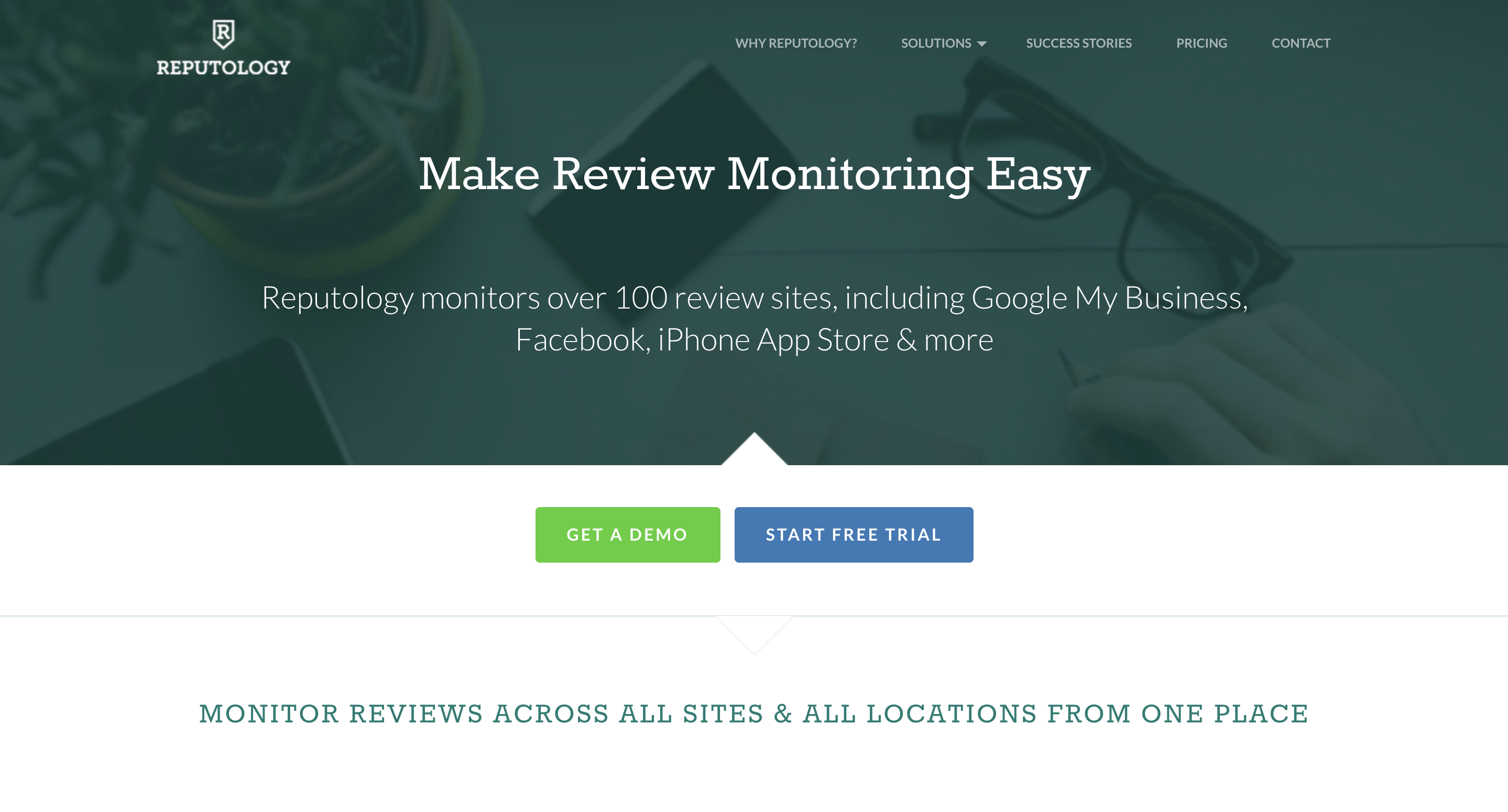
Targeting multi-location businesses, Reputology focuses on review management across various sites, emphasizing local SEO and centralized feedback management.
Each of these tools offers a unique blend of features, addressing different needs in the sphere of online reputation management. When selecting a tool, consider the broader scope of your business needs, including competitive analysis, customer engagement, marketing integration, and local SEO enhancement, to ensure a comprehensive approach to managing your online presence.
For businesses seeking to manage their online reputation cost-effectively, there are several free review monitoring tools that offer fundamental functionalities. These tools are ideal for getting started with tracking and responding to online reviews, crucial for maintaining a positive public image:
Google Alerts: This tool is versatile, albeit not exclusively designed for review monitoring. By setting up Google Alerts, businesses can receive notifications about any web mentions, including reviews on different platforms. This broad coverage is especially beneficial for monitoring general brand sentiment and catching reviews that might be posted on blogs, news sites, or other less conventional platforms.
ReviewPush: This tool provides a free version specifically designed for monitoring major review sites. For businesses primarily concerned with reviews on platforms like Yelp, TripAdvisor, or Google, ReviewPush offers a streamlined way to stay updated with customer feedback. This focused approach can be particularly effective for businesses in service industries like hospitality or retail, where these platforms are heavily used.
Facebook Page Insights: For businesses active on Facebook, Page Insights is an invaluable tool. It not only tracks reviews and ratings but also offers analytics on customer interactions on the platform. This is particularly useful for businesses that use Facebook as a primary channel for customer engagement and promotions. Insights gained can guide content strategy, customer service approaches, and even product development based on customer feedback and engagement trends.
While these free tools lack some advanced features of paid software, they are an excellent starting point for small businesses or those new to online reputation management. They provide key capabilities to monitor reviews and mentions, crucial for timely responses to customer feedback and effective management of online presence.
For businesses looking for a more comprehensive solution that includes competitor review monitoring, Competitors App emerges as a strong option. It offers a broader perspective by not only tracking your reviews but also providing insights into how competitors are perceived by customers. This competitive intelligence can be instrumental in refining your strategies and staying ahead in your industry. The Competitors App blends the basic necessities of review monitoring with the strategic advantage of competitive analysis, making it a well-rounded choice for businesses ready to invest in robust online reputation management.

Monitoring reviews on Google is crucial for businesses, given the platform’s widespread use and influence on customer decisions. Here’s a guide to effectively monitor and manage reviews on Google:
Claim and Verify Your Google My Business Listing: The first step is to claim your business on Google My Business. This allows you to manage your business information, respond to reviews, and gain insights into customer interactions.
Regularly Check for New Reviews: Make a habit of regularly checking your Google My Business account for new reviews. Prompt attention to reviews can impact customer perceptions positively.
Set Up Alerts for New Reviews: While Google My Business doesn’t directly provide review alerts, you can use third-party tools or set up Google Alerts to be notified of new mentions of your business, which can include reviews on Google.
Respond to Reviews Professionally: Whether a review is positive or negative, responding professionally is key. Acknowledge positive reviews with gratitude and address negative reviews by offering solutions or clarifications.
Analyze Review Trends: Look for patterns in your Google reviews. Are there recurring compliments or complaints? Use this feedback to identify areas of strength and opportunities for improvement in your business.
Encourage Happy Customers to Leave Reviews: Don’t hesitate to ask satisfied customers to share their experiences on Google. Positive reviews can significantly boost your business’s online reputation.
Monitor Competitor Reviews: Keeping an eye on competitors’ Google reviews can provide valuable market insights and help you understand customer expectations in your industry.
Leverage Reviews for SEO: Google reviews can influence your local SEO. Positive reviews and active engagement can improve your visibility in search results, attracting more customers.
Effectively managing your Google reviews is a vital part of your online reputation strategy. It requires regular attention and proactive engagement, but the benefits in terms of customer trust, business insights, and search engine visibility are substantial.
Monitoring product reviews is a critical aspect of managing a business’s online presence, especially for e-commerce and retail companies. Here’s a detailed approach to effective product review monitoring:
Identify Key Platforms: Determine where your products are being reviewed. This could include your own website, e-commerce platforms like Amazon or eBay, G2 or specific social media channels.
Implement Monitoring Tools: Use specialized tools designed for product review monitoring. These tools can aggregate reviews from multiple platforms, making it easier to track and analyze them.
Regularly Check for New Reviews: Establish a routine to regularly check for new reviews. This helps in staying updated and responding promptly, which is crucial for customer engagement and satisfaction.
Analyze Reviews for Insights: Go beyond just reading the reviews. Analyze them for patterns and trends that can offer insights into customer preferences, product performance, and potential areas for improvement.
Respond to Reviews: Engage with your customers by responding to their reviews. Thank customers for positive feedback and address any issues raised in negative reviews. This interaction shows that you value customer feedback and are committed to improving their experience.
Incorporate Feedback into Product Development: Use the insights gained from reviews to inform product development and improvements. Customer feedback can be a goldmine for enhancing product quality and functionality.
Manage Negative Reviews Effectively: Develop a strategy for managing negative reviews. This might involve reaching out to dissatisfied customers, offering solutions, or making changes to the product based on their feedback.
Leverage Positive Reviews in Marketing: Positive reviews can be powerful marketing tools. Showcase them on your website, in social media posts, or in promotional materials to build trust and credibility.
Train Your Team: Ensure your team understands the importance of product review monitoring and how to effectively manage it. This includes training in customer service, communication, and analysis.
Effective product review monitoring not only helps in managing your online reputation but also provides valuable customer insights, aids in product development, and enhances marketing efforts. By actively engaging with customer reviews, you can strengthen your brand, improve customer satisfaction, and drive business growth.
For businesses of all sizes, monitoring reviews is a crucial aspect of managing their online reputation and customer relations. Here’s how to effectively engage in business review monitoring:
Identify Review Platforms Relevant to Your Business: Different businesses may find their customers leaving reviews on different platforms. Identify where your customers are most active – be it Google, Yelp, industry-specific review sites, or social media platforms like Facebook and LinkedIn.
Set Up Monitoring Systems: Utilize review monitoring tools that can track reviews across these various platforms. These tools can automate the process, saving time and ensuring that no review goes unnoticed.
Regularly Analyze Review Data: Consistently analyze the reviews for insights. Look for patterns in customer feedback that can highlight strengths or areas for improvement in your products, services, or customer service approaches.
Train Your Team on Response Strategies: Equip your team with guidelines on how to respond to reviews, both positive and negative. Personalized and professional responses can enhance customer trust and loyalty.
Incorporate Feedback into Business Strategies: Use the insights gathered from reviews to inform and adjust your business strategies. Customer feedback can be invaluable in refining your offerings and improving customer experience.
Encourage Customers to Leave Reviews: Actively encourage satisfied customers to leave reviews. This not only generates more feedback but can also positively influence potential customers.
Respond to Reviews Promptly and Professionally: Prompt responses to reviews show customers that you value their feedback. Addressing complaints swiftly can help in mitigating any negative impacts.
Use Positive Reviews in Marketing: Leverage positive reviews in your marketing materials. Testimonials and customer success stories can be powerful tools in attracting new customers.
Stay Updated with Industry Trends: Monitor reviews not just for direct feedback, but also to stay informed about broader industry trends and customer expectations.
Review Monitoring as an Ongoing Process: Treat review monitoring as a continuous process, not a one-time task. The digital landscape and customer opinions are always evolving, and staying on top of reviews is key to maintaining a positive business reputation.
By actively engaging in business review monitoring, companies can gain critical insights into customer satisfaction, improve their service offerings, enhance their online presence, and ultimately drive business growth.
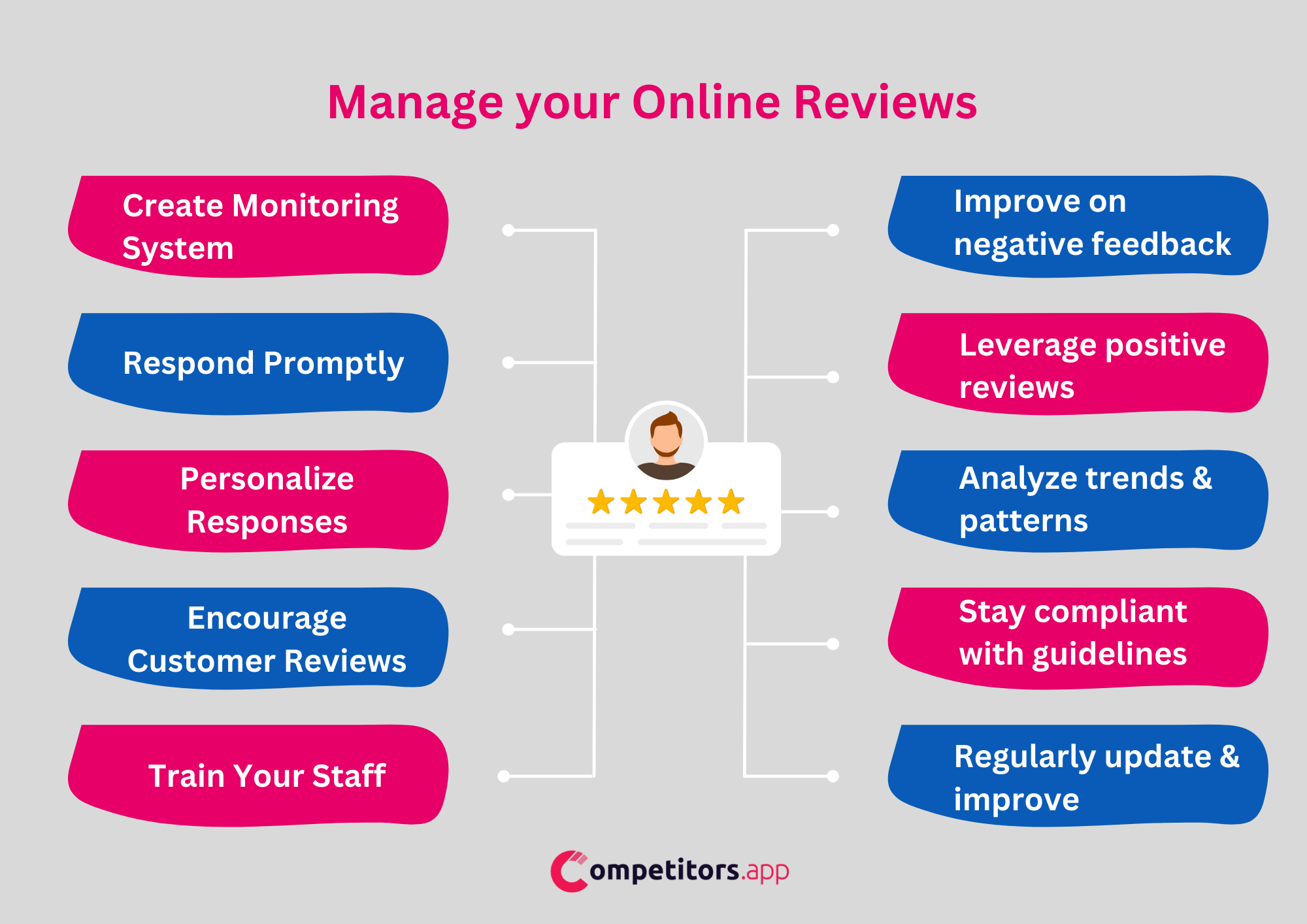
Managing your online reviews effectively is a critical component of maintaining a strong digital presence and a positive reputation. Here’s a strategic approach to managing online reviews:
Develop a Monitoring System: Establish a system for regularly checking reviews across various platforms. Utilize tools that can help aggregate and notify you of new reviews to streamline the process.
Respond Promptly and Professionally: Timely responses to reviews are key. Whether a review is positive or negative, acknowledge it with professionalism. This shows current and potential customers that you value feedback and are attentive to customer needs.
Personalize Your Responses: Tailor your responses to the specific comments of each review. Avoid generic responses, as personalized engagement is more likely to resonate with both the reviewer and others reading the reviews.
Encourage Reviews from Customers: Actively encourage your customers to leave reviews. This can be done post-purchase or through follow-up emails. More reviews give a broader picture of customer experiences and opinions.
Train Your Staff: Ensure your team is trained in best practices for managing online reviews. They should understand the importance of maintaining a positive tone and offering helpful solutions where necessary.
Use Negative Reviews Constructively: View negative feedback as an opportunity to improve. Address the concerns raised and use the feedback to make necessary changes in your products, services, or customer service approach.
Leverage Positive Reviews: Showcase positive reviews in your marketing materials. They serve as testimonials and can significantly boost your brand’s credibility and attract new customers.
Analyze Trends and Patterns: Regularly analyze the reviews for common themes. This analysis can offer valuable insights into customer preferences, expectations, and areas that may need improvement.
Stay Compliant with Platform Guidelines: Each review platform has its own set of guidelines. Ensure your review management practices comply with these rules to maintain a positive standing on each platform.
Regularly Update Your Review Management Strategy: The digital landscape and consumer behavior are constantly evolving. Regularly assess and update your review management strategy to keep it effective.
By implementing these strategies, businesses can effectively manage their online reviews, turning them into powerful tools for building trust, improving customer service, and ultimately driving growth.
Creating an effective online review monitoring strategy involves integrating several key aspects:

Utilizing Latent Semantic Indexing keywords is vital for understanding customer feedback in depth. These keywords help in identifying trends and patterns, enhancing SEO, and gaining a clearer understanding of customer sentiment.

Implementing sentiment analysis is crucial for categorizing reviews into positive, negative, or neutral. This approach provides a more detailed picture of overall customer satisfaction and helps in pinpointing areas that need attention.

Keeping an eye on your competitors’ reviews offers invaluable insights. It helps in understanding market trends, customer expectations, and areas where your business can improve or differentiate itself.

Negative reviews should be viewed as opportunities for growth. Addressing these reviews effectively can highlight your commitment to customer satisfaction and can turn potential negatives into positive experiences, enhancing your business reputation.
Incorporating these elements into your review monitoring strategy can significantly enhance your ability to manage online feedback, improve customer relations, and strengthen your brand’s online presence.
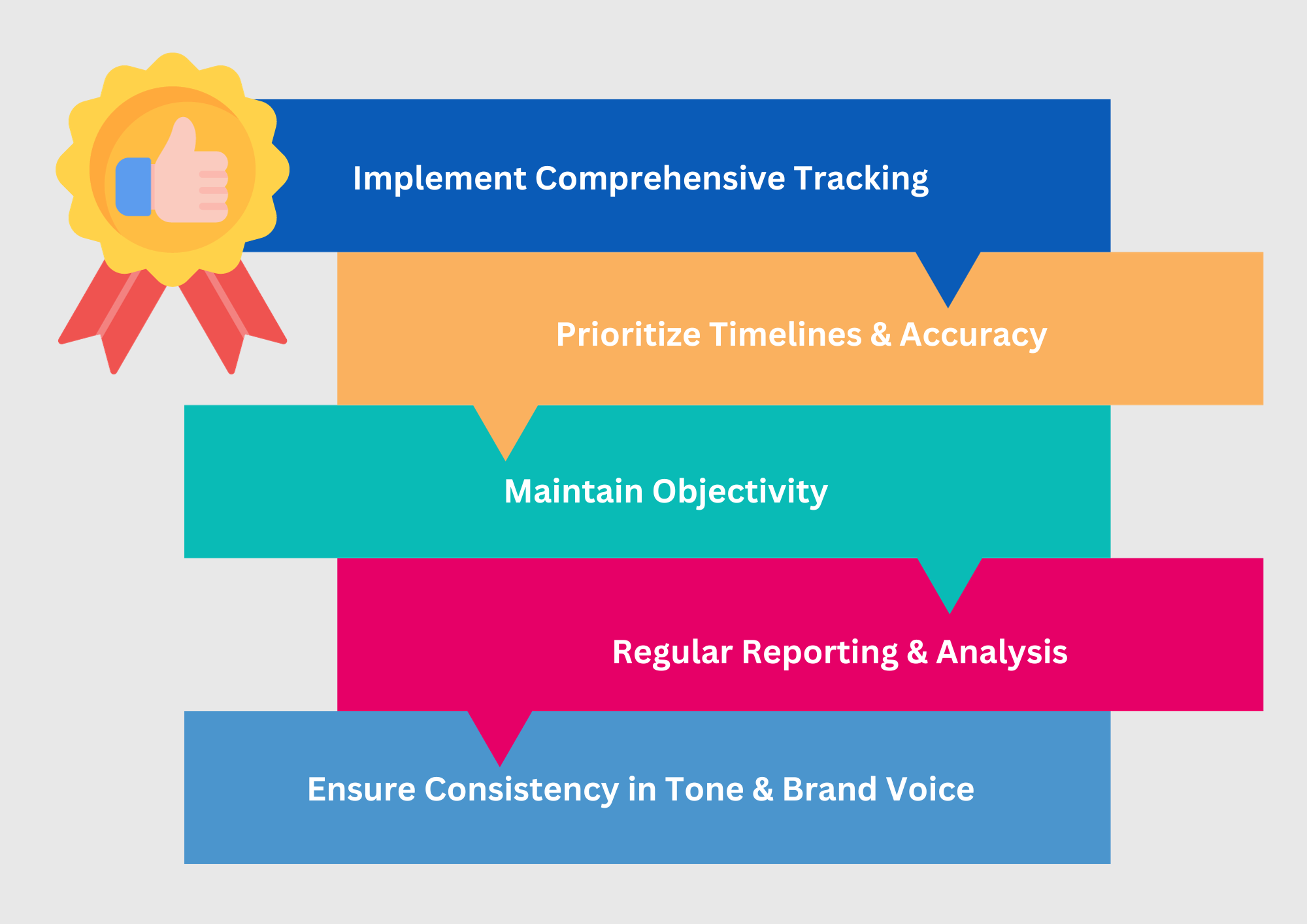
To effectively monitor reviews and maintain a positive online reputation, it’s essential to adopt certain best practices:
Implement Comprehensive Tracking: Ensure that your review monitoring covers all major platforms relevant to your industry. This comprehensive approach helps in capturing a full spectrum of customer feedback.
Prioritize Timeliness and Accuracy: Quick and accurate responses to reviews are crucial. Ensure that the information you provide in responses is correct and relevant to the customer’s feedback.
Maintain Objectivity: When monitoring and responding to reviews, it’s important to stay objective, especially in handling negative feedback. Avoid taking criticism personally and focus on providing constructive solutions.
Regular Reporting and Analysis: Set up a system for regular reporting and analysis of review data. This should include identifying trends, tracking changes in customer sentiment, and measuring the impact of your responses.
Ensure Consistency in Tone and Brand Voice: Consistency in the tone and voice of your responses across different platforms is key to maintaining brand integrity. Tailor your responses to align with your brand’s personality and values.
While review monitoring is essential for maintaining a positive online presence, it comes with its own set of challenges and pitfalls. Understanding these can help businesses navigate the process more effectively:
Volume of Reviews: For businesses receiving a high volume of reviews, it can be challenging to keep track and respond to each one individually. This requires efficient management strategies and potentially the use of automated tools.
Fake Reviews: The presence of fake or misleading reviews can skew the perception of your business. Identifying and addressing these reviews in compliance with platform policies is crucial.
Balancing Negative and Positive Feedback: It’s easy to get swayed by negative feedback, but balancing the attention between negative and positive reviews is important for a fair representation of customer sentiment.
Responding to Negative Reviews Appropriately: Crafting appropriate responses to negative reviews without escalating the situation or sounding defensive is a delicate task that requires tact and professionalism.
Maintaining Consistency Across Platforms: Different review platforms may have varying norms and user expectations. Maintaining a consistent brand voice while adapting to these differences can be challenging.
Keeping Responses Personal and Genuine: Avoiding canned or generic responses is essential to show customers that their feedback is truly valued. Personalizing responses while managing a large number of reviews can be resource-intensive.
Legal and Ethical Considerations: Navigating the legal and ethical aspects, such as respecting customer privacy and adhering to platform guidelines, is vital.
Analysis and Actionable Insights: Collecting reviews is just one part; the real challenge lies in analyzing them for actionable insights and integrating this feedback into business improvements.
Resource Allocation: Allocating the right amount of resources, including time and personnel, for effective review monitoring can be a balancing act, especially for smaller businesses.
Staying Current with Trends: Online review landscapes are continuously evolving. Staying updated with the latest trends and adapting your strategy accordingly is essential for ongoing effectiveness.
By understanding and preparing for these challenges, businesses can develop more robust strategies for review monitoring, ensuring they maximize the benefits while minimizing the potential downsides.
The use of proxies in review monitoring is a strategic approach to effectively manage and analyze online reviews, especially when handling a large volume of data or accessing reviews from different geographic regions. Here’s how proxies can be beneficial in review monitoring:
Accessing Geo-Restricted Content: Proxies can help bypass geographical restrictions, allowing businesses to access and monitor reviews from different regions. This is particularly useful for international companies or those planning to expand into new markets.
Maintaining Anonymity: When using proxies, your real IP address is hidden. This anonymity is crucial for businesses wanting to conduct competitor analysis without revealing their identity.
Managing Large Scale Monitoring: For businesses that need to monitor a vast number of reviews across various platforms, proxies can facilitate this process by distributing requests across different servers, thus avoiding IP bans or rate limits.
Speed and Efficiency: Proxies can improve the speed and efficiency of data collection, especially when dealing with large-scale review monitoring. This leads to quicker analysis and more timely responses to customer feedback.
Security and Privacy: Using proxies adds an extra layer of security and privacy, safeguarding your business’s online activities and sensitive data.
Accurate Localized Data: Proxies allow businesses to access reviews as they appear to users in specific locations, ensuring the data collected is relevant and accurate for that particular market.
Implementing proxies in review monitoring can significantly enhance a business’s ability to gather and analyze customer feedback effectively, providing a more comprehensive understanding of its online reputation across different markets.
Incorporating a review monitoring API (Application Programming Interface) into your business tools can transform how you handle online reviews. An excellent example of this is the Competitors App, which offers an API for efficient review monitoring. Here’s how utilizing a review monitoring API, like the one from Competitors App, can benefit your business:
Automated Data Collection: The API automates the collection of reviews from various platforms. This saves time and effort, allowing for real-time monitoring and faster responses to customer feedback.
Customizable Data Retrieval: You can tailor the API to fetch specific information, such as ratings, review texts, and sources, ensuring you receive data that’s most pertinent to your business.
Integration with Existing Systems: The API can be integrated into your existing CRM or analytics systems. This creates a unified platform for easier review management and analysis.
Scalability and Flexibility: APIs like the one from Competitors App are scalable, catering to businesses of all sizes and adaptable to changing business needs.
Sentiment Analysis Tools: Many APIs, including the Competitors App’s, offer sentiment analysis, categorizing reviews into positive, negative, or neutral sentiments. This feature helps in quickly assessing overall customer sentiment.
Comprehensive Analytics and Reporting: Generate in-depth analytics and reports on review data to understand customer trends, improve offerings, and make informed business decisions.
Timely Alerts and Notifications: Set up notifications for new reviews or specific triggers, such as a surge in negative feedback. This feature ensures that businesses can respond promptly and effectively.
By leveraging a review monitoring API like the one offered by Competitors App, businesses can significantly enhance their capability to track, analyze, and act on online reviews, leading to more effective online reputation management and customer engagement strategies.
In the context of review monitoring, businesses often have several common questions. Addressing these FAQs can provide clarity and enhance understanding of this crucial aspect of reputation management:
Almost all customer-facing industries benefit from review monitoring, especially hospitality, retail, e-commerce, and service-oriented sectors. These industries rely heavily on customer perceptions and feedback for their success.
The "best" tool varies based on specific business needs, industry, and the scale of operations. Tools like ReviewTrackers, Podium, and Competitors App are popular for their comprehensive features and user-friendliness.
Monitoring should be a continuous process. Ideally, businesses should check for new reviews daily to ensure timely responses and up-to-date understanding of customer sentiment.
White label review monitoring refers to using third-party review monitoring tools that are rebranded to appear as part of your company’s own toolkit. This is especially useful for agencies that manage reputation for multiple clients. Competitors App offers the ability to fully whitelabel the software.
While businesses can monitor for fake reviews about their products, setting up a system to generate fake reviews is unethical and against the policies of most platforms. Instead, focus on encouraging authentic reviews from real customers.
Provide excellent customer service, follow up with customers after a purchase, and make it easy for them to leave reviews. You can also politely ask satisfied customers to share their experience online.
Yes, responding to all reviews, both positive and negative, is advisable as it demonstrates that you value customer feedback and are committed to customer satisfaction.